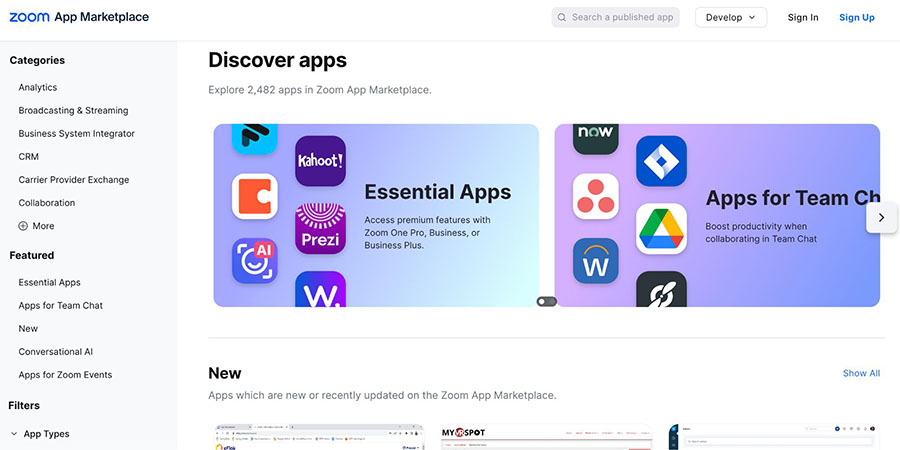The rise of remote and hybrid work led businesses to a shift in video conferencing platforms to facilitate virtual meetings. Since then, video conferencing providers introduced advanced features to ensure seamless collaboration, including whiteboarding and artificial intelligence (AI). In this article, we explore the latest video conferencing statistics, industry leaders, and how they have shaped the modern workplace.
Video Conferencing Statistics & Trends
The growing demand for unified communications created opportunities both for providers and the distributed workforce. Hybrid meeting setups became the new form of collaboration, allowing companies to incorporate digital solutions into in-person meetings. These video conferencing stats show how the widespread adoption of virtual meetings delivered new industry trends.
1. The global video conferencing market share is anticipated to reach $95 billion by 2032
(Source: Global Market Insights)
The growing focus on the integration of advanced technologies is driving the growth of the video conferencing market landscape. Industry players like Zoom, Cisco, and Microsoft are working on product innovations to expand their market presence. These service providers are offering additional features, such as higher audio-video quality, automated note-taking, facial recognition, and active noise cancellation.
2. Only 38% of employers upgraded their video technology to support hybrid collaboration
(Source: Owl Labs)
The rise of hybrid work is forcing companies to operate differently, including the tools and spaces employees use to connect and collaborate. However, only 38% of employers have invested in new video technology to support hybrid collaboration. This involves upgrading to video-enabled meeting rooms or conference halls to achieve the effect of telepresence as if all participants are sitting next to each other.
3. Tuesday is the busiest day for virtual meetings
(Source: Zoom)
Popular video meeting software Zoom found Tuesday is the busiest day for virtual meetings, with January and October 2022 seeing the most action. In hybrid work, Monday is the most popular day of the week to schedule meetings. On average, Wednesdays have the longest meetings, and Fridays have slightly fewer meetings at an average of 40 minutes.
4. Gen Zs are most likely to meet via video, while millennials are more likely to use whiteboards
(Source: Zoom)
In a survey by Zoom, nearly all participants said they use a combination of tools to stay connected at work, with phone, team chat, and video conferencing the most common choices. However, communication preferences may differ across age generations. For example, Gen Zs are most likely to meet via video, while millennials are more likely to collaborate through whiteboards.
5. 64% of remote employees prefer a hybrid video conferencing call
(Source: Owl Labs)
With hybrid work becoming more common, employees are setting expectations on virtual meetings. More than half of the remote workforce say their preferred meeting style is a hybrid video conference meeting. It involves participants joining from an on-site venue (i.e., office, meeting room) while others join remotely. This creates a culture where employees can work flexibly while still allowing seamless collaboration.
If you need a video conferencing solution designed for hybrid working, check out Webex Meetings. It is a purpose-built suite for hybrid work that includes meetings, whiteboarding, and built-in AI tools. Conference devices like Webex Desk and Webex Board Pro facilitate video-first collaboration, brainstorming, and content sharing. Read our Webex review to see if it fits your needs.

Webex offers a hybrid meeting solution that blends the key aspects of virtual and in-person collaboration. (Source: Webex)
Key Takeaway:
To enable the hybrid work landscape, companies should invest in technologies that help maintain seamless collaboration between remote and office workers. In this case, the right video conferencing solution will help bridge the gap across different work locations, thanks to intelligent tools like live transcription, transcripts, and virtual whiteboards.
Video Conferencing Usage Statistics
As companies began to partially return to physical workspaces, video conferencing usage has slightly decreased across industries. But this isn’t the case for remote teams that have made video meetings an integral part of their business models. Below are video conferencing usage statistics showing how this technology continues to shape remote work.
6. 71% of employees say it’s easier to present to a group during video meetings
(Source: Owl Labs)
Regardless of how engaging physical meetings might be, more employees find online meetings more seamless when presenting or participating in group discussions. Presenters can use immersive video meeting tools like Q&A, whiteboard, and co-annotation, making meetings more engaging instead of just having the audience sit around and listen. The in-meeting chat function allows participants to ask questions without disturbing the flow of the discussion.
7. The most time-effective video meetings finish in 13 minutes or less
(Source: Dialpad)
According to Dialpad’s State of Video Conferencing report, stand-ups are the most efficient type of meetings, as they only take 13 minutes or less on average. They often occur in small groups of under 20 people or less. Stand-ups are quick status meetings where the team goes over the most important matters of the day.
8. Video meetings with 10 attendees or fewer take 13 minutes or less
(Source: Dialpad)
Setting meeting titles as “huddles” with less than 10 invited participants tends to finish in less than 13 minutes, according to Dialpad. Meeting duration will shoot up to 30 minutes once you exceed 10 participants. However, using “team meeting” instead of “huddle” for your meeting titles can likely go on for over an hour. These patterns indicate that the number of invited participants and how you name your meetings directly affect the duration.
9. 43% of employees are having virtual meetings from their cars
(Source: Zoom)
Attending meetings while in the car is the most popular non-desk location for meetings outside the office. Meeting from the bed is most common for Gen Zs (61%) and higher for women (29%). This is followed by coffee shops, airports, and while walking or jogging.
10. Third-party integrations are the top missing feature for most video conferencing users
(Source: Dialpad)
A Dialpad survey revealed 52% of employees said their video conferencing platform doesn’t meet all their needs. The top four missing features include third-party integrations, browser-based meetings, real-time transcriptions, and the ability to meet on any device.
Zoom is the top video conferencing solution due to its feature-rich free plan and extensive collaboration capabilities. It’s also known for its robust integrations with over 2,200 third-party apps, including popular business software for productivity, project management, and customer service. Head over to our full Zoom review to learn more about its built-in video meeting tools.

The Zoom App Marketplace offers a complete list of third-party apps users can connect with their Zoom Meetings account.
(Source: Zoom)
Key Takeaway:
With remote work here to stay, video conferencing will remain a key component in enhancing communication and collaborative experiences across teams. However, it’s important for companies to recognize the usage patterns of employees to find the right video meeting solution and features to perform their jobs efficiently.
Virtual Meeting Productivity Statistics
Video conferencing is a popular productivity tool that allows teams to collaborate in real time and brainstorm on the spot. However, scheduling countless video meetings eventually harms productivity by hindering employees’ ability to focus on more important tasks. The following statistics on video conferencing reveal its impact on employee productivity.
11. Employees spend 45% of their time with their audio or video turned off when attending “unnecessary” video meetings
(Source: Otter.ai)
Most employees prefer to turn off their audio or video when attending a meeting that is not directly related to their work. One primary reason is it allows them to multitask and make productive use of their time. In a Dialpad 2022 report, 89.9% of employees believe that not all meetings require video, while 44.94% believe that meetings that don’t involve the use of screen sharing can be done as an audio call.
12. Almost 90% of employees multitask during video meetings
The majority of employees often find a way to get their usual work done during video meetings. While 90% are in-meeting multitaskers, 10% of those respondents admit they always multitask, and 74% percent multitask occasionally. In fact, multitasking is a common meeting distraction in 12 states, including Colorado, Louisiana, Nevada, Utah, and Washington.
13. Checking emails is the most common off-task behavior during virtual meetings
Employees try to do their jobs more efficiently by checking emails during virtual meetings. However, others are tempted to do non-work related tasks, such as reading the news or browsing social media. Those who work from home take advantage of their time by doing childcare or household chores.
14. Over 55% of workers say most of their video meetings could have been an email
(Source: Zippia)
While meetings are a great way to collaborate and engage with the team, more than half of employees think that most of their video meetings could have been an email instead. They will rather receive an email if the purpose is to make a general announcement or ask a simple question. For them, virtual meetings are only required if a group discussion is involved and all attendees are required to contribute.
15. 32.7% of video conferencing participants feel unhelpful meetings are a waste of time
(Source: Dialpad)
Employees tune out of meetings if they’re too long, unproductive, or a waste of time. These types of meetings often lack progress or conclusion, especially when the discussion drifts away from the original agenda or purpose. A video conference is considered productive if they benefit something from it or if the goal of the meeting is met.
Microsoft Teams is an all-in-one workspace with team chat, video conferencing, and file sharing. This provider aims to boost other forms of collaboration besides video chat in the form of virtual workspaces, channels, and collaborative editing. Our Microsoft Teams review covers everything you need to know about its pricing, features, and customer support.

Channels are collaborative workspaces where teams can participate in chats, mention team members, and edit files in real time.
(Source: Microsoft Teams)
Key Takeaway:
When time is poorly used or facilitated in meetings, it becomes counterproductive for employees. A combination of healthy work habits and the right meeting tools is the key to making meeting experiences more pleasant and less stressful. Investing in a team collaboration tool helps streamline remote work processes and reduce cognitive overload.
Video Meeting Challenges Statistics
Although video conferencing has plenty to offer remote and hybrid meetings, it comes with its own challenges. Technical issues, fatigue, and reduced focus are just some of the pain points experienced by many remote workers. Here, we explain video conferencing stats showing how virtual meetings affected the daily workflow and employee well-being.
16. Audio quality issues are the biggest pain point for virtual meetings
(Source: Dialpad)
Audio quality issues like mic echo, background noise, or forgetting to mute and unmute are the top complaints for video meeting participants. In remote working, it has become more crucial for companies to address system glitches that impede communication and workflow. Often, this usually comes down to poor internet connection, including packet loss and network delays.
17. 28.6% of employees find creating meeting reports is the top stressor in meetings
(Source: Deputy)
Preparing meeting reports is the leading cause of stress during meetings. Meeting reports include a detailed summary of the meeting, including the agenda, attendees, timelines, and all the key points discussed. If done manually, documenting meetings can be time and energy-consuming, particularly large-scale meetings. This significantly affects the employees’ productivity and ability to contribute to the conversation.
18. 49% of employees experience fatigue due to being on a webcam
(Source: Virtira)
While turning the webcam on is best for establishing team engagement and connection, employees report that it caused distraction and affected their inability to concentrate during meetings. The idea of having to look at themselves creates a feeling of self-consciousness, and the need to focus the eyes on a busy screen leads to sensory overload.
Key Takeaway:
Business owners and managers can create a productive work environment by being more intentional when scheduling virtual meetings. For instance, make it a habit to prepare meeting agenda and stick to the schedule to prevent fatigue. As a team, decide when turning on videos are necessary, otherwise, opt for quick voice calls or audio recordings instead.
19. Excessive eye contact is the primary reason why video calls cause fatigue
(Source: Stanford University)
According to Stanford research, the amount of eye contact increases dramatically during video conferencing. Most of the time, everyone is looking at each other, so as soon as someone moves, everyone’s eyes go to a specific person to see what they’re doing. Exaggerated eye contact can make you feel like you’re the focus of everyone’s attention, leading to a stressful experience.
20. 14% more women experience video meeting fatigue than men
(Source: RedRex)
Women are more likely to experience exhaustion during video meetings because of the constant pressure to do their hair, get all dressed up, and wear makeup. They become more critical of themselves the longer they see themselves on the screen.
RingCentral Video is our top recommended video conference software, as it offers a free and feature-packed solution for collaborative teams. Besides hosting meetings, users can use the team messaging feature and task management tool to deliver companywide announcements and manage team workloads. Get to know this provider as a unified communications solution in our RingCentral review.

From voice calling, team messaging, and video calls, RingCentral offers the most convenient ways to communicate. (Source: RingCentral)
Frequently Asked Questions (FAQs)
What is the difference between web vs video conferencing?
Web conferencing refers to online presentations or events that involve one-way communication, where a host addresses a large audience. This applies to webinars, lectures, or professional presentations. Video conferencing, on the other hand, is a collaborative session in which all meeting participants can see and talk to each other.
What is Zoom fatigue?
Zoom fatigue refers to the exhaustion or burnout associated with prolonged video meetings. This is prevalent among remote employees engaging in frequent and long hours of video conferencing. This often stems from the lack of body language, continuous eye contact, increased self-awareness, and multitasking opportunities.
What are the latest video conferencing trends?
Some of the key trends in the video conferencing market include hybrid meetings, 4k streaming, 3D teleconferencing, and AI-powered interactive tools. As video meetings become a workplace norm, users have higher expectations for the performance and quality of their video conferencing platforms.
Bottom Line
The video conferencing statistics we have enumerated in this piece prove that video meetings have become a critical element in managing a successful remote or hybrid workforce. It enables teams to replicate the collaborative experience of in-person meetings without the time and expense associated with the daily commute. To fully reap its benefits, choose a video conferencing provider that supports the unique needs of your remote team.